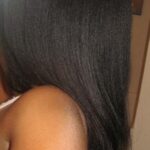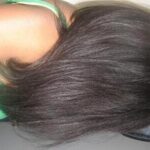The outer layer of each hair shaft is called the cuticle. They are composed of overlapping, scale-like cells. These cells lie flat if the hair is treated gently and the proper balance of moisture and oils plus acidity is maintained. If the cuticle becomes dry, broken, or rubbed away, the hair is lifeless, dull, and unmanageable. The sun, hot appliances, teasing, coloring, straightening, or permanent waving all tend to break down the hair’s cuticle. Taking care of your hair the correct way helps to maintain healthy, smooth, and shiny hair.
Brush your hair one or two times each day, especially before shampooing, to distribute scalp oils and to prevent tangling. The more thicker and courser your hair is, the stiffer the brush bristles should be. Brush bristles should be nylon, plastic, or natural (boar bristle), but should have rounded tips as well as smooth shafts.
To brush correctly, bend at the waist and use gentle, slow motions as you pull the brush through your hair from the nape of your neck forward. This helps to protect your hair at the top of your head and around your face.
If you shampoo every day, lather hair only once and condition it. You may want to lather your hair twice if your hair is very oily or your scalp is sweaty. If you wash your hair less frequently you should lather twice. Shampoo cleans hair with a mixture of detergents and water. Any extra ingredients such as, herbs, protein, beer, or oils may impart a pleasant scent or feel and helps to improve manageability or add luster. Most shampoos are pH balanced, whether it is advertised or not, to protect the cuticle.
The most efficient way to shampoo is in the shower with your back to the spray. Wet your hair thoroughly, lather the shampoo between your palms, and apply it to your hair and scalp. Don’t pile your hair on top of your head, but instead start off with a scalp massage, using the balls of your fingers versus using your nails. Then work the shampoo down the hair strands. When you are done washing, be sure to completely rinse away all of the shampoo from your hair. Lift sections of long hair to be certain spray penetrates underneath.
Conditioning makes hair more manageable by neutralizing the electrical charges caused by shampooing and combing. Some conditioners have oils, proteins, and silicone to help add sheen. Read the labels of different types of conditioners to determine which is right for your hair. Apply a conditioner after each shampoo, following the directions on the label. Be sure to rinse thoroughly. If you have oily hair, then just condition the ends. If your hair is fine and also oily, try conditioning before shampooing.
Dry your hair by blotting, not rubbing, with a towel. Use a wide-tooth comb or your fingers to detangle wet hair. Start at the bottom and work your way up to the scalp. Don’t brush fragile wet hair. Air dry your hair as much as possible. Use a blow dryer, rollers, or a curling iron only for the finishing touches.






